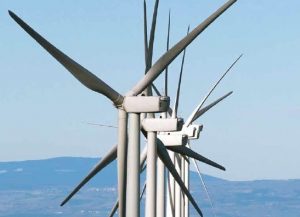Windflow Technology has achieved a major engineering success with the news today that Lloyd’s Register has awarded its Type Approval Certificate to the Windflow 500 turbine. This confirms that the turbine meets Class 1A of the latest International Electrotechnical Commission (IEC) design standard IEC 61400-1 (edition 3). Class 1A certification attests that the Windflow 500 will operate for more than 20 years in the strongest, most turbulent wind regime in the IEC classification. The company reports that certification has required years of engineering horsepower and has set a new standard in wind turbine excellence in the medium size 500 kW category.
It gives interested parties and purchasers of the Windflow 500 turbine confidence that the turbine has been rigorously tested to operate in the highest strength winds. During the IEC process 2,800 pages of engineering calculations were scrutinized by Lloyd’s Register, along with more than 200 drawings and 37 specifications; the prototype turbine at Gebbies Pass (near Christchurch) was put through a regime of safety and mechanical load tests, as well as measuring its acoustics and power output. The blade was tested for its ultimate strength by the University of Canterbury and for its fatigue life at the IRL test hall in Auckland.
According to CEO Geoff Henderson the confirmation of IEC certification is the end of an engineering marathon and a strong kick-start to the international marketing drive that recently gained critical momentum through a policy change in the U.K. The company has assembled a team of 20 professional engineers in its Christchurch headquarters supported by the company’s commercial team, the skilled tradespeople in its nacelle assembly and blade factories, and the windsmiths in Palmerston North servicing its 66 operating turbines. The company, which is the only utility-scale wind turbine manufacturer in Australasia, currently employs more than 50 people directly and about 400 indirectly throughout New Zealand.
“We are immensely proud of our team’s work, and despite challenges along the way we always believed that our innovative Windflow 500 would speak for itself and affirm the confidence of our shareholders,” Henderson says. “Windflow Technology, and the Windflow 500, have set a new wind energy benchmark and one that our supporters can feel very excited about. The turbine is designed for New Zealand’s lean and mean economic environment as well as our turbulent high wind sites. Its fundamental economic advantage is that it uses fewer tonnes of materials, typically 50 percent, for the same output as competing three-bladers, large or midsize. The class 1A IEC Type Approval validates this lighter, smarter approach to operating at high wind sites.”
Wind turbine certification is an independent determination that provides assurance of a turbine performing for a minimum of 20 years in a specified environment. Because the IEC certification standard prescribes required safety margins for all engineering calculations, compliance provides the statistical backup sought by those who finance and insure wind farms.
Currently 66 Windflow 500 turbines are installed in New Zealand. A full-scale prototype has been operating since 2003 at Gebbies Pass near Christchurch. Five began operation at the Te Rere Hau wind farm on the outskirts of Palmerston North in 2006, with another 60 being installed at Te Rere Hau between November 2008 and October 2009. In addition 32 turbines are in production and are planned to be installed at Te Rere Hau by mid-2011. To learn more go to www.windflow.co.nz.



























